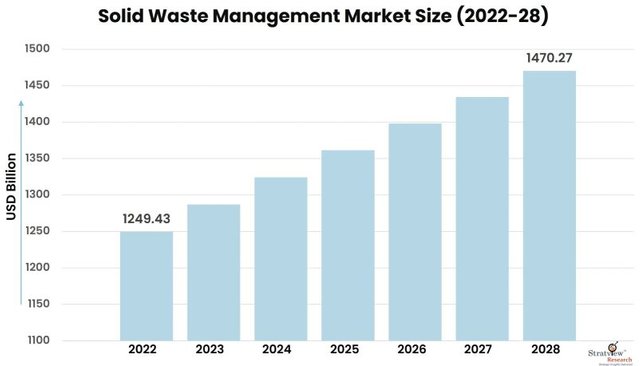Solid Waste Management Market Trends: Shaping the Future of Waste Solutions
The solid waste management market is experiencing rapid transformation as global awareness around environmental sustainability grows. Driven by urbanization, population growth, and the rising demand for waste reduction solutions, this market is evolving with innovative approaches and forward-thinking strategies. Here, we explore some of the key trends shaping the future of waste solutions.
According to Stratview Research, the solid waste management market was estimated at USD 1249.43 billion in 2022 and is likely to grow at a CAGR of 2.69% during 2023-2028 to reach USD 1470.27 billion in 2028.

1. Emphasis on Sustainable Waste Disposal
With more countries enforcing stringent environmental regulations, there is a significant shift toward sustainable waste disposal methods. Governments and industries are increasingly focusing on recycling, composting, and waste-to-energy (WTE) technologies to reduce landfill dependency. The circular economy model, which emphasizes reducing, reusing, and recycling waste, is gaining traction globally. Companies across industries are adopting zero-waste initiatives to minimize their environmental footprint, setting the stage for sustained growth in the solid waste management market.
2. Technology-Driven Solutions
Innovations such as artificial intelligence (AI), robotics, and the Internet of Things (IoT) are transforming waste management processes. Smart bins, for example, can detect fill levels and automatically signal for collection, optimizing collection routes and reducing emissions. AI-powered sorting machines are also becoming more common in recycling facilities, helping to enhance efficiency by accurately categorizing waste types. These advancements make waste management more effective, less labor-intensive, and environmentally friendly.
3. Increased Investment in Waste-to-Energy Technologies
Waste-to-energy (WTE) is an area of significant interest, as it provides dual benefits: waste reduction and renewable energy generation. By converting waste materials into usable energy, WTE technologies help reduce landfill accumulation while providing an alternative energy source. This trend is particularly strong in urban areas with limited space, where the demand for cleaner energy sources is high. Countries in Europe and Asia are leading the charge in adopting WTE plants, signaling a promising future for this market segment.
4. Focus on Biodegradable and Eco-Friendly Packaging
The surge in single-use plastics and packaging materials has intensified the need for biodegradable options. Many companies are shifting toward eco-friendly packaging solutions, responding to both regulatory pressure and consumer demand. As more businesses transition to sustainable packaging, the demand for effective waste management solutions tailored to biodegradable materials will increase, creating new market opportunities.
Conclusion
The solid waste management market is poised for substantial growth, driven by innovative technologies, regulatory pressures, and sustainability goals. As these trends evolve, the market will continue to shape a future where waste is minimized, resources are maximized, and environmental impacts are significantly reduced. Through these efforts, solid waste management is not only addressing current waste challenges but also paving the way for a cleaner, more sustainable world.